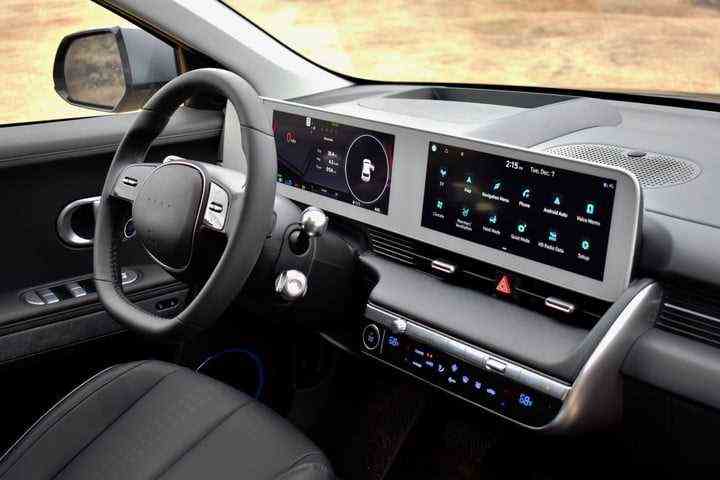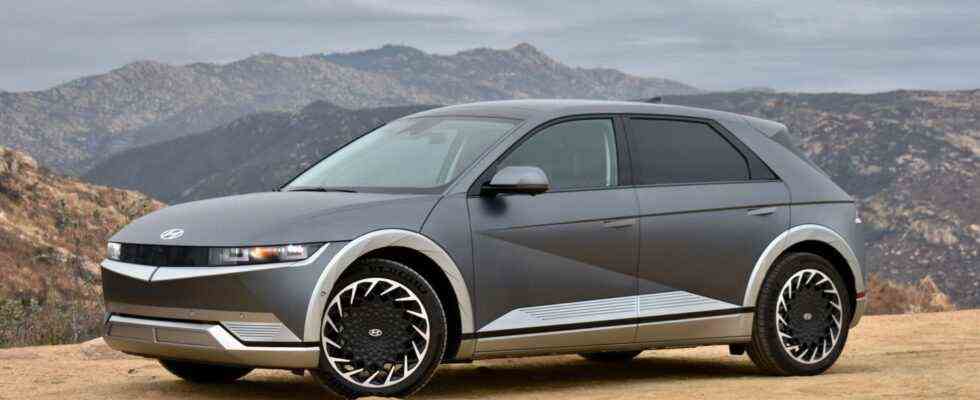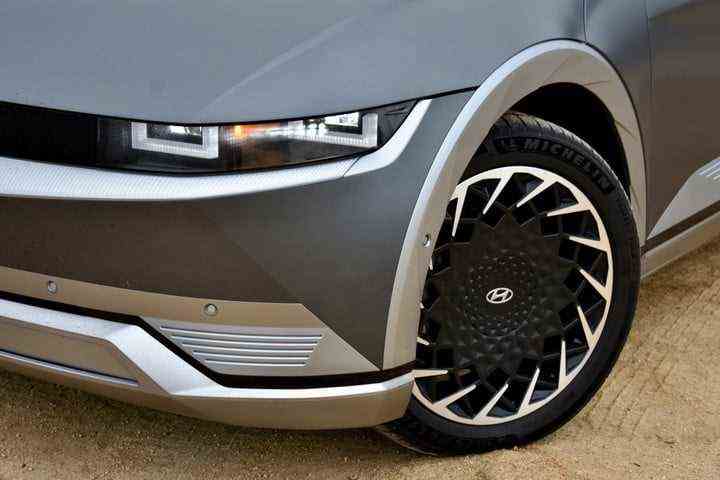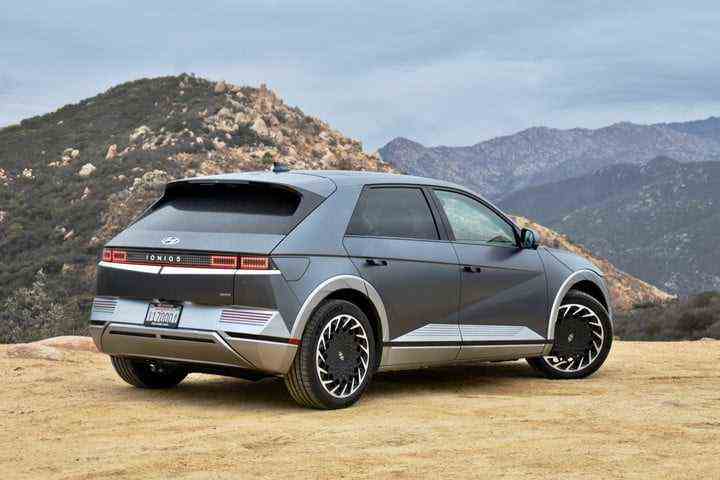The 2022 Hyundai Ioniq 5, the automaker’s newest electric car, proves that EVs are about more than a powertrain.
Hyundai has launched electric cars before, but they were derived from gasoline or hybrid models. The Ioniq 5 is a clean-sheet design, debuting Hyundai’s EV-specific Electric-Global Modular Platform (E-GMP) and taking advantage of the design freedom that entails. That makes the Ioniq 5 a stronger competitor to the Volkswagen ID.4, Ford Mustang Mach-E, and Tesla Model Y.
Hyundai isn’t stopping there. The Ioniq 5 is the first in a series of Ioniq models sharing the E-GMP platform and general design theme. An Ioniq 6 sedan and Ioniq 7 SUV are on the way as well. Note that the Ioniq sub-brand is separate from the current Hyundai Ioniq hatchback, an unrelated model sold with hybrid, plug-in hybrid, and all-electric powertrains.
On sale in later December, the Ioniq 5 launches in SE, SEL, and Limited trim levels with standard rear-wheel drive or available all-wheel drive. Launch pricing starts at $44,875 for a rear-wheel-drive SE model, while our range-topping all-wheel-drive Limited test car had a $55,725 base price (all prices include a mandatory $1,225 destination charge). An SE Standard Range model with a smaller battery pack will arrive in spring 2022, starting at $40,925.
The Ioniq 5 qualifies for the $7,500 federal EV tax credit and may qualify for additional state or local incentives depending on where you live.

Design and interior
The Ioniq 5 blends retro and modern styling elements for a design that’s much more distinctive than the generic futurism of many other EVs. Two-tone bodywork and sharp lines, particularly a beak-like convergence at the front bumper, give the Ioniq 5 a unique look. Headlights and taillights with pixel-like elements add a retro touch, while available aero-design 20-inch wheels and flush door handles help reduce aerodynamic drag, Hyundai says. Where many EVs rely on one or two design features to stand out, these many unique elements combine to make the Ioniq 5 look like nothing else on the road.
Like the exterior, the interior is refreshingly different. Instead of covering things up with extra trim, Hyundai kept things simple. The horizontal screen sits proud of the dashboard, and the door panels curve outward, creating more elbow room. The flat floor creates a greater feeling of space as well, and made room for a number of handy storage nooks. Hyundai even included a reclining driver’s seat that lifts your legs, so you can take a nap while you charge.
Hyundai calls the Ioniq 5 a crossover, but that’s just marketing spin. The crossover term implies the taller ride height and driving position of an SUV, but on both counts, the Ioniq 5 seemed about the same as an ordinary car. The Ioniq 5’s styling is also based on the Hyundai 45 concept, which in turn was inspired by the 1975 Hyundai Pony. The first car designed in-house by Hyundai, the Pony was a hatchback that predated the crossover trend by decades. Still, crossovers are the hottest vehicle segment in the United States right now, so Hyundai’s just doing what it needs to do to move more metal.
The Ioniq 5 looks like nothing else on the road.
An unusual result of the Ioniq 5’s E-GMP platform is a super-long wheelbase. The Ioniq 5 is about the size of a normal compact car, but Hyundai says the 118.1-inch wheelbase is longer than its Palisade three-row SUVs. We’d normally expect that to pay dividends in passenger space, but the Ioniq 5 doesn’t have a clear advantage over its rivals.
The Hyundai has more first-row and second-row legroom than the VW ID.4, but the Ford Mustang Mach-E offers more room in front, while the Tesla Model Y offers more room in both rows. Headroom is back of the pack in most cases, although second-row occupants get a little more than in the VW. The Hyundai’s main advantage is shoulder room, so occupants get a greater sense of space, at least.
At 27.2 cubic feet of cargo space with the rear seats in place, the Ioniq 5 trails the Mach-E and ID.4 (Tesla doesn’t publish a comparable figure for the Model Y).
Tech, infotainment, and driver assist
The standard infotainment system includes a pair of 12.3-inch screens placed side by side. One serves as the instrument cluster, the other as the main touchscreen. Wired Apple CarPlay and Android Auto are standard, along with Amazon Alexa and Google Assistant compatibility. A revamped Hyundai Blue Link app also allows drivers to remotely schedule charging, check range, or preset the climate control. Those features are free through the first three years of ownership.
As with other recent Hyundai models, we found the infotainment system easy to use and were impressed by the touchscreen’s menu layout and graphics. An added bonus here is the Mercedes-like augmented reality head-up display that projects navigation arrows onto the windshield, ensuring you don’t miss any turns.
The Ioniq 5 also gets the Digital Key feature that debuted on the Hyundai Sonata sedan, which allows drivers to use a smartphone instead of a key fob. While some automakers’ remote apps can lock or unlock doors, Digital Key lets you start the car and drive away without a fob. Ford is offering a similar feature on the Mustang Mach-E, however.
As with other recent Hyundai models, we found the infotainment system easy to use.
The list of standard driver-assist features includes Forward Collision Avoidance Assist, which essentially combines forward-collision warning and front automatic emergency braking. The basic version can detect oncoming vehicles, pedestrians, and cyclists and apply the brakes if necessary, according to Hyundai. SEL and Limited models get a more advanced version that can detect vehicles approaching from the side at intersections and in adjacent lanes, along with evasive steering assist.
Also standard is a Blind-Spot Collision Avoidance Assist system that combines blind-spot monitoring with an automatic braking feature designed to pull the car back into its lane if another vehicle is detected. Limited models also get Hyundai’s nifty Blind-Spot View Monitor, which shows a camera view of the blind spot in the instrument cluster when turn signals are activated. Hyundai’s Remote Smart Parking Assist is available as well.
Highway Driving Assist, which combines adaptive cruise control with automated lane centering, is standard on the base SE trim level. The SEL and Limited get Highway Driving Assist 2, which adds a lane-change assist feature, a lane-placement feature that can move the car within its lane to avoid obstacles like a vehicle parked on the shoulder, and a machine-learning function that can tailor the system to the owner’s driving style, Hyundai said.
We didn’t spend enough time with the car to test that out, and we weren’t impressed with the system overall. The lane-centering feature brought us unnervingly close to other cars, and this isn’t a hands-off system like the Chevrolet Bolt EUV’s Super Cruise, or the BlueCruise system that’s being added to the Ford Mustang Mach-E via software update.
Driving experience
At launch, the Ioniq 5 gets a 77.4-kilowatt-hour lithium-ion battery pack and single-motor rear-wheel drive or dual-motor all-wheel-drive powertrains. Rear-wheel-drive models have 225 horsepower and 258 pound-feet of torque while all-wheel-drive models produce 320 hp and 446 lb-ft of torque. The aforementioned SE Standard Range model will have a 58-kWh pack and 168 hp single-motor rear-wheel-drive powertrain when it joins the lineup in spring 2022.
Hyundai says our all-wheel-drive test car will do zero to 60 mph in 5.1 seconds. That looks pretty good on paper, and it’s 0.3 seconds quicker than an all-wheel-drive VW ID.4, but it’s not enough to really stand out. Drivers coming from gasoline cars will be in for a treat, but those cross-shopping the Ioniq 5 with other EVs will be used to the punchy acceleration offered by electric powertrains’ instant torque delivery.
Nothing about the way the Ioniq 5 drove really stood out.
The rest of the driving experience followed that pattern. The Ioniq 5 was reasonably quiet and comfortable and didn’t embarrass itself in the corners, but nothing about the way it drove really stood out. This Hyundai lacked the VW ID.4’s feeling of solidity, the sportiness of the Ford Mustang Mach-E, and the refinement of the Volvo XC40 Recharge our Ioniq 5 Limited test car nearly matched in price.
A Hyundai Kona Electric we drove recently seemed incapable of one-pedal driving, but Hyundai has addressed that with the Ioniq 5’s i-Pedal system. The level of regeneration was high enough that we avoided using the brake pedal most of the time. It can even bring the car to a full stop, but not in a short enough distance for everyday use, in our experience.
Range, charging, and safety
The Ioniq 5 gets an EPA-rated 303 miles of range with rear-wheel drive and the larger 77.4-kWh battery pack, with efficiency ratings of 114 MPGe combined (132 MPGe city, 98 MPGe highway). The all-wheel drive version is rated at 256 miles of range and 98 MPGe combined (110 MPGe city, 87 MPGe highway). With its smaller 58-kWh battery pack, the rear-wheel drive SE Standard Range is rated at 220 miles of range and 110 MPGe combined (127 MPGe city, 94 MPGe highway).
Hyundai claims the Ioniq 5’s main competitive advantage will be charging. The Ioniq 5 has an 800-volt charging architecture that allows for DC fast charging from 10% to 80% charge in 18 minutes, according to Hyundai. However, that’s only doable at stations that can charge at 250 kilowatts or more. Those are fairly rare, but at the more common 150-kW stations, Hyundai says the Ioniq 5 can charge from 10% to 80% in a still-respectable 25 minutes. Hyundai is also including two years of unlimited free 30-minute charging sessions on the Electrify America network.
With the 240-volt Level 2 AC charging stations typically used for home charging, Hyundai says a 10% to 100% charge will take six hours and 43 minutes. The Ioniq 5 also has what Hyundai calls vehicle-to-load, allowing the car to power electronics, or even charge other EVs.
Crash-test ratings from the Insurance Institute for Highway Safety (IIHS) and National Highway Traffic Safety Administration (NHTSA) weren’t available at the time of publication. That’s not unusual for new models.
The Ioniq 5 gets the same five-year, 60,000-mile, new vehicle warranty and 10-year, 100,000-mile, powertrain warranty as gasoline Hyundai models, which are among the best warranty terms in the business. Hyundai EVs also get a 10-year, 100,000-mile, battery warranty, which is competitive with other EV battery warranties.
How DT would configure this car
Maximizing tech means going for the top Limited trim level. The Ioniq 5 Limited gets a head-up display, Bose audio system, surround-view and Blind-Spot View Monitor camera systems, and Remote Smart Parking Assist. It also gets tech features from the lower trim levels, including Highway Driving Assist 2 and the dual 12.3-inch screens.
The Limited model is available with both rear-wheel drive and all-wheel drive. While it sacrifices power, we’d be inclined to go with rear-wheel drive because it provides 303 miles of range and saves about $4,000 MSRP over a comparable all-wheel-drive model. However, drivers in snowier climates might still want to consider the dual-motor all-wheel-drive powertrain.
Our take
The 2022 Hyundai Ioniq 5 is nice to drive and fields plenty of tech but the EV market is getting more competitive.
With a $41,190 base price and 260-mile range, the base rear-wheel-drive Volkswagen ID.4 Pro undercuts the Ioniq 5 SE long-range model in price and will offer more range than the Ioniq 5 SE Standard Range when that model launches in spring 2022. The VW also drives a bit nicer than the Hyundai, in our opinion, but its touch-based controls are more difficult to use, and Hyundai offers more sophisticated driver-assist tech.
The Ford Mustang Mach-E brings sporty driving dynamics and a massive 15.5-inch touchscreen to the table. Buyers can also spec BlueCruise which, unlike Hyundai’s Highway Driving Assist 2, allows for hands-off driving in certain situations. However, Hyundai offers more range for your money.
The high-end Ioniq 5 Limited trim level is also priced close to premium-brand EVs like the Polestar 2 and Volvo XC40 Recharge, but the Hyundai’s slate of driver aids and its 800-volt charging hardware give it an advantage on value. A recent price increase means the Tesla Model Y now starts at about $60,000 — substantially more than anything else discussed here.
So while the Ioniq 5 doesn’t knock its rivals to the mat on range and price, it’s still competitive. It’s also worth considering Hyundai’s generous warranty terms and the 800-volt charging capability, although the latter is dependent on the proliferation of more-powerful DC fast-charging stations.
Should you get one?
Yes. The Ioniq 5 is an excellent blend of style and tech.
Editors’ Recommendations





